Words by Lisa Burns
After hearing the news that 21-year-old cyclist Joshua Jarvis was killed in a collision with a truck in Fallowfield last Tuesday, I was saddened. I was not surprised, however.
After getting my hands on a bike in the summer, I have spent the past few months cycling everywhere. I have to say, it’s been a bit of an eye-opener. I’ve had numerous near-misses, making me realise time and again that cyclists are considered second-class citizens on the road. Let me give you a few examples.
There was the time a driver left me with literally an inch between her and the pavement, then wondered why I almost scraped her car. There was the crazy boy-racer who rolled down his window to scream obscenities at me – apparently my manoeuvring around traffic cones on a tight corner wasn’t quite thrilling enough for him. There are the bus drivers who pull out of bus stops without indicating, and then honk their horns as if to jolt my latent psychic powers into action. Sorry, it was raining- my sixth sense antenna was down.

Holland Cycle Lane
But the mother of all hazards has to be the cycle lane, or rather the misuse of them. Some drivers seem to think that cycle lanes exist for their parking needs at all hours of the day. Their obstruction forces cyclists to swerve into the road, much to the irritation of drivers. This creates an endless vicious circle of antagonism between cyclist and driver. Also, it seems that in parts of Manchester, a cycle lane is viewed as a handy alternative to a rubbish bin. I’ve had to swerve around discarded umbrellas, broken glass, cardboard boxes, cutlery, to name but a few.
What is the purpose of a cycle lane? Funnily enough, the clue is in the name. It’s there for the cyclist’s safety, but when obstructed by vehicles and litter, its purpose is defeated. Perhaps it’s time to take a leaf out of Holland’s book and invest in the construction of safe, effective cycle lanes separate from the road. (It’s worth noting that H.G. Wells said cycle lanes would abound in Utopia – we’re not quite there yet!)
Eyes must be peeled at all times when on a bike. Pedestrians! Why stop to let a car pass, but then leap out into the road when a cyclist approaches? What is the internal monologue in that situation? ‘Oh it’s ok, that’s just a cyclist. They’re not reeeallly on the road, are they? I’m sure they could pole-vault over me if they were really that bothered.’ Common sense seems to evaporate in these instances. It’s quite easy: I’m trundling down the road at quite a pace. If we collide, it’s going to hurt. For both of us. Capiche?

Pedestrian Expectations can be Quite High
I’ve discussed these events with my friends and I know I’m not alone. In the first week of cycling in Manchester, one was knocked clean off her bike by an overenthusiastic driver on Curry Mile. Another collided with a car that failed to give way at a junction (luckily, just outside the hospital, so an x-ray was mere metres away. Hurrah.).
Don’t get me wrong. I’ve seen cyclists put themselves and others at risk. You know the ones I mean – they hurtle through red lights rocking out to their latest Ipod playlist, as though the rules of life and death don’t apply to them. Obviously common sense is a must to ensure safety on the road.
Needless to say, helmets, hi-visibility clothing and bike lights are lifesavers – but they can only do so much. Awareness and respect is necessary from all parties; cyclists, pedestrians and drivers. No one has a monopoly over the road, we share it. 122 cyclists died in 2012 in road collisions. For them, and for Joshua Jarvis, it’s too late. How many more cyclists will meet the same fate before something changes?
Lisa Burns studies History and English at MMU. When she’s not got her nose in a book, she loves having adventures in the great outdoors! Follow her on Twitter: @LittleRobin09

aAh! Magazine is Manchester Metropolitan University's arts and culture magazine.








Leave a reply